CORPOREALITY, DIGITAL TECHNOLOGIES AND AGEING: REFRAMES OF THE OLD AGE IN THE EDUCATIONAL PROCESS.
CORPOREALITY, DIGITAL TECHNOLOGIES AND AGEING: REFRAMES OF THE OLD AGE IN THE EDUCATIONAL PROCESS.
DOI:
https://doi.org/10.22478/ufpb.2359-7003.2019v28n3.47823Keywords:
Education, Media, Body, Digital technologies, AgingAbstract
This paper discusses how digital technologies modify the social relations of an old age group, within the academic space and in daily life – based on the relationship between body, media and ageing. In the Federal University of Paraíba (UFPB), some students of the French Course of the Núcleo Integrado de Estudos e Pesquisas da Terceira Idade (NIETI –Integrated Center for Old Age Studies and Research) were taken up for study. One sought to understand their demands and complexities for a reframe, concerning to old age nowadays. As a methodological approach, semi-structured interviews and participant observation were used. Regarding to the theoretical framework, this study interacts with authors fromsociology, anthropology, communication and education, such as Campelo (1996), Buckingham (2010), Stepansky (2012), Martín Barbero (2014) and Longhi (2018). As a conclusion, digital technologies modify the social practices of the old age, and become pedagogies in the process of affective relationships, in yearnings for interaction with other groups, and in the search for belonging to an educational space.
Downloads
References
ALMEIDA, T.; LOURENÇO, M. L. Reflexões: conceitos, estereótipos e mitos acerca da velhice. RBCEH, Passo Fundo, v. 6, n. 2, 2009.
BARROS, M. M. L. de. Trajetória dos estudos de velhice no brasil. Sociologia, Problemas e Práticas, n.º 52, 2006.
BUCKINGHAM, David. Cultura Digital, Educação Midiática e o Lugar da Escolarização. Educação e Realidade, Porto Alegre, v. 35, n.3, 2010.
CAMARANO, A. A.; KANSO, S.; LEITAO E MELLO, J. Como vive o idoso brasileiro? Os novos idosos brasileiros: muito além dos 60? Rio de Janeiro: IPEA, 2004.
CAMPELO, C. R. O corpo e seus textos. In: CAMPELO, C. R. Cal(e)idoscorpos: um estudo semiótico do corpo e seus códigos. São Paulo: Annablume, 1996.
CASTELLS, Manuel. A sociedade em rede. São Paulo: Paz e Terra, 1999.
COSTA, M. V.; ANDRADE, P. D. Na produtiva confluência entre educação e comunicação, as pedagogias culturais contemporâneas. Perspectiva. Florianópolis, v. 33, n. 2, 2015.
DANTAS, Marcelo; OLIVEIRA JÚNIOR, Pedro; MARQUES, Dayvid; VIANA, Marco. Os benefícios da inclusão digital na terceira idade - relato de experiência. In: Anais do Congresso Internacional de Educação e Inclusão. Campina Grande-PB: UEPB, 2014.
ELIAS, N. Os estabelecidos e os outsiders. Rio de Janeiro: Jorge Zahar Editor, 2000.
FERRIGNO, J.C. Co-educação entre gerações. Petropólis (RJ): Vozes, 2003.
FOUCAULT, Michel. O corpo utópico, as heterotopias. São Paulo: N-1 Edições, 2013.
INSTITUTO BRASILEIRO DE GEOGRAFIA E ESTATÍSTICA (IBGE) – Estudos e Análise. Disponível em: <https://ww2.ibge.gov.br/home/estatistica/populacao/alteracoes_e_impactos/default.shtm>. Acesso em: 23 jul. 2019.
______. Pesquisa Nacional por Amostra de Domicílios (PNAD) 2018.
Disponível em: < https://www.ibge.gov.br/estatisticas/sociais/trabalho/17270-pnad-continua.html?=&t=o-que-e>. Acesso em: 30 ago. 2019.
LONGHI, M. R. Eu tô fazendo certo, tô não? Envelhecimento, políticas de saúde e relações de cuidado. In: MALUF, Sônia Weidner; SILVA, Érica Quinaglia (Org.). Estado, Políticas e Agenciamentos Sociais em Saúde: Etnografias comparadas. Florianópolis: Editora da UFSC, 2018.
MARTÍN BARBERO, Jesús. A comunicação na educação. São Paulo: Contexto, 2014.
MCLUHAN, Marshall. Os meios de comunicação como extensões do homem.
São Paulo: Cultrix, 1964.
MONERO, C. & GISBERT, D.D. Tramas: procedimentos para a aprendizagem cooperativa. Porto Alegre: Artmed, 2005
MOTTA, Alda Britto da. A atualidade do conceito de gerações na pesquisa sobre o envelhecimento. Revista Sociedade e Estado. V. 25, nº 2, 2010.
NEVES, Luiz Felipe Baêta. Corpo, velhice, projeto e neoliberalismo. In: VILLAÇA. F. G., KOSOVSKY, E. Que corpo é esse? Rio de Janeiro: Mauad. 2012.
ORGANIZAÇÃO DAS NAÇÕES UNIDAS (ONU). Plano de ação internacional contra o envelhecimento./Organização das Nações Unidas; tradução de Arlene Santos. –– Brasília: Secretaria Especial dos Direitos Humanos, 2003.
PEREIRA, Rogério Santos. Multiletramentos, tecnologias digitais e os lugares do corpo na educação. Tese doutorado - Universidade Federal de Santa Catarina, Programa de Pós-Graduação em Educação. Florianópolis, 2014.
STEPANSKY, D. Velhice, imaginário e cidadania. In: VILLAÇA. F. G., KOSOVSKY, E. Que corpo é esse?, Rio de Janeiro: Mauad. 2012.
TRINDADE, Liane; GICO, Vânia. Tecnologias da Informação, Terceira Idade e Educação. In: Anais do XXXII Congresso Brasileiro de Ciências da Comunicação. Curitiba: 2009.
ZORRÓN BERLINCK; MATTOS BERLINCK. Terceira Idade e Tecnologia. Comunicação & Educação, São Paulo, v. 11, n. 48 a 52, 1998.
Downloads
Published
How to Cite
Issue
Section
License
Authors who publish in this journal agree to the following terms:
. Authors retain the copyright and grant the journal the right to first publication, with the work simultaneously licensed under the Licença Creative Commons Attribution that allows the sharing of the work with acknowledgment of authorship and initial publication in this magazine. . Authors are authorized to assume additional contracts separately, for non-exclusive distribution of the version of the work published in this journal (eg, publishing in institutional repository or as a book chapter), with acknowledgment of authorship and initial publication in this journal.
. Authors are permitted and encouraged to publish and distribute their work online (eg in institutional repositories or on their personal page) at any point before or during the editorial process, as this can generate productive changes, as well as increase impact and citation of the published work (See O Efeito do Acesso Livre).



















